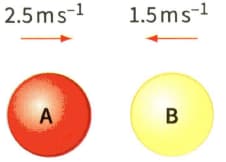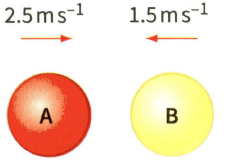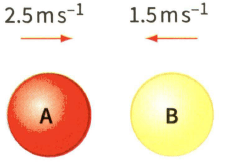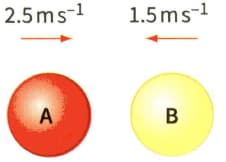Figure shows two identical balls A and B about to make a head-on collision. After the collision, ball A rebound at a speed of And ball B rebounds at a speed of . The mass of each ball is .

(b) Calculate the momentum of each ball after the collision.

Important Questions on Momentum
Figure shows two identical balls A and B about to make a head-on collision. After the collision, ball A rebound at a speed of And ball B rebounds at a speed of . The mass of each ball is .

(c) Is the momentum conserved in the collision?
Figure shows two identical balls A and B about to make a head-on collision. After the collision, ball A rebound at a speed of And ball B rebounds at a speed of . The mass of each ball is .

(d) Show that the total kinetic energy of the two balls is conserved in the collision.
Figure shows two identical balls A and B about to make a head-on collision. After the collision, ball A rebound at a speed of And ball B rebounds at a speed of . The mass of each ball is .

(e) Show that the relative speed of the balls is the same before and after the collision.
A trolley of mass is moving at . It collides with a stationary trolley of mass . This second trolley moves off at .
(a) Draw 'before' and 'after' diagrams to show the situation.
A trolley of mass is moving at . It collides with a stationary trolley of mass . This second trolley moves off at .
(b) Use the principle of conservation of momentum to calculate the speed of the first trolley after the collision. In what direction does it move?
Discuss whether momentum is conserved in each of the following situations.
(a) A star explodes in all directions - a supernova.
Discuss whether momentum is conserved in each of the following situations.
You jump up from a trampoline. As you go up, your speed decreases; as you come down again, your speed increases.
